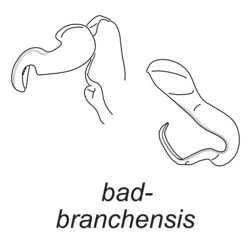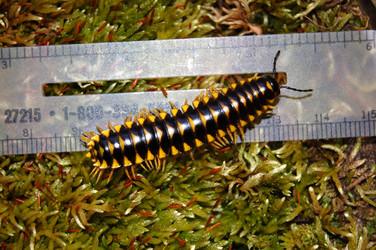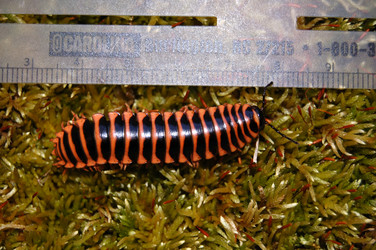Brachoria badbranchensis
The Bad Branch Mimic Millipede
Paul MarekCharacteristics
Brachoria badbranchensis individuals are about 42.3 mm long and 9.8 mm wide (females 49.2 mm X 11.10 mm). Color: Striped yellow (10YR 8/14, shown above) or pink; and 3-spotted yellow.


Brachoria badbranchensis genitalia - left male gonopodal acropodite (with setae removed): (Left) medial view and (Right) magnified apical view. © Paul Marek


Brachoria badbranchensis, 3-spotted yellow color morph. © Paul Marek


Brachoria badbranchensis, striped pink color morph. © Paul Marek
Habitat
Brachoria badbranchensis specimens were collected during the day (15:00) in a forest comprising rhododendron, maple, umbrella magnolia, and hemlock trees. Millipedes were encountered between a lowland moist hemlock forest and an upland relatively drier maple and oak forest. Individuals were found beneath layers of decomposing leaf material near Bad Branch, about 30 m above (west of) the water. Another population of B. badbranchensis occurs on the north slope of Pine Mountain in James E. Bickford Nature Preserve (see B. gracilipes for habitat details there). One other xystodesmid encountered sympatrically at the Bad Branch locality is Apheloria virginiensis corrugata, which has a mimetic resemblance with B. badbranchensis. Other xystodesmids encountered on the nature preserve were B. splendida, B. gracilipes, Pleuroloma flavipes, and undescribed species of Nannaria. Note: Individuals of B. badbranchensis may easily be confused in the field with A. virginiensis corrugata, B. splendida, B. gracilipes, and P. flavipes due to similarity in color patterns and overlap in distribution.Distribution
Known only from the type locality in Letcher Co., Kentucky and James E. Bickford Nature Preserve near the town of Pine Mountain in Harlan Co., KY. The closest known Brachoria species, B. hoffmani, occurs about 15 air km northeast in Jefferson National Forest near Pound Gap, Wise County, Virginia. Brachoria insolita occurs about 22 air km southeast in Norton City, Virginia.Conservation status
Brachoria badbranchensis is threatened by habitat loss due to agriculture (especially growing demand for paper products), coal mining, development, and the invasion of exotic species.References
Marek P.E. 2010. A revision of the Appalachian millipede genus Brachoria Chamberlin, 1939 (Polydesmida: Xystodesmidae: Apheloriini). Zool. J. Linn. Soc. 159: 817-889.
Title Illustrations

| Scientific Name | Brachoria badbranchensis |
|---|---|
| Location | USA, Kentucky, Letcher Co. |
| Reference | Marek P.E. 2010. A revision of the Appalachian millipede genus Brachoria Chamberlin, 1939 (Polydesmida: Xystodesmidae: Apheloriini). Zool. J. Linn. Soc. 159: 817-889. |
| Specimen Condition | Live Specimen |
| Sex | m |
| Life Cycle Stage | adult |
| View | dorsal |
| Collection | FMNH |
| Type | holotype |
| Collector | Paul Marek |
| Image Use |
 This media file is licensed under the Creative Commons Attribution-NonCommercial License - Version 3.0. This media file is licensed under the Creative Commons Attribution-NonCommercial License - Version 3.0.
|
| Copyright |
© Paul Marek

|
About This Page
Work on the millipede Tree of Life pages was supported by a U.S. National Science Foundation Doctoral Dissertation Improvement Grant to Paul Marek and Jason Bond (DEB 0607996) and a Partnerships for Enhancing Expertise in Taxonomy Grant to Petra Sierwald, Jason Bond, and William Shear (DEB 0529715).
Paul Marek

Virginia Polytechnic Institute and State University
Correspondence regarding this page should be directed to Paul Marek at
Page copyright © 2010 Paul Marek
 Page: Tree of Life
Brachoria badbranchensis . The Bad Branch Mimic Millipede.
Authored by
Paul Marek.
The TEXT of this page is licensed under the
Creative Commons Attribution-NonCommercial License - Version 3.0. Note that images and other media
featured on this page are each governed by their own license, and they may or may not be available
for reuse. Click on an image or a media link to access the media data window, which provides the
relevant licensing information. For the general terms and conditions of ToL material reuse and
redistribution, please see the Tree of Life Copyright
Policies.
Page: Tree of Life
Brachoria badbranchensis . The Bad Branch Mimic Millipede.
Authored by
Paul Marek.
The TEXT of this page is licensed under the
Creative Commons Attribution-NonCommercial License - Version 3.0. Note that images and other media
featured on this page are each governed by their own license, and they may or may not be available
for reuse. Click on an image or a media link to access the media data window, which provides the
relevant licensing information. For the general terms and conditions of ToL material reuse and
redistribution, please see the Tree of Life Copyright
Policies.
- First online 16 September 2010
- Content changed 16 September 2010
Citing this page:
Marek, Paul. 2010. Brachoria badbranchensis . The Bad Branch Mimic Millipede. Version 16 September 2010 (under construction). http://tolweb.org/Brachoria_badbranchensis/144819/2010.09.16 in The Tree of Life Web Project, http://tolweb.org/






 Go to quick links
Go to quick search
Go to navigation for this section of the ToL site
Go to detailed links for the ToL site
Go to quick links
Go to quick search
Go to navigation for this section of the ToL site
Go to detailed links for the ToL site